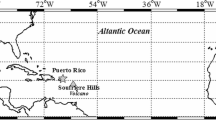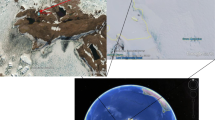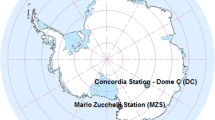Abstract
High volume bulk aerosol samples were collected continuously at three Antarctic sites: Mawson (67.60° S, 62.50° E) from 20 February 1987 to 6 January 1992; Palmer Station (64.77° S, 64.06° W) from 3 April 1990 to 15 June 1991; and Marsh (62.18° S, 58.30° W) from 28 March 1990, to 1 May 1991. All samples were analyzed for Na+, SO 2−4 , NO −3 , methanesulfonate (MSA), NH +4 ,210Pb, and7Be. At Mawson for which we have a multiple year data set, the annual mean concentration of each species sometimes vary significantly from one year to the next: Na+, 68–151 ng m−3; NO −3 , 25–30 ng m−3; nss SO 2−4 , 81–97 ng m−3; MSA, 19–28 ng m−3; NH +4 , 16–21 ng m−3;210Pb, 0.75–0.86 fCi m−3. Results from multiple variable regression of non-sea-salt (nss) SO 2−4 with MSA and NO −3 as the independent variables indicates that, at Mawson, the nss SO 2−4 /MSA ratio resulting from the oxidation of dimethylsulfide (DMS) is 2.80±0.13, about 13% lower than our earlier estimate (3.22) that was based on 2.5 years of data. A similar analysis indicates that the ratio at Palmer is about 40% lower, 1.71±0.10, and more comparable to previous results over the southern oceans. These results when combined with previously published data suggest that the differences in the ratio may reflect a more rapid loss of MSA relative to nss SO 2−4 during transport over Antarctica from the oceanic source region. The mean210Pb concentrations at Palmer and Marsh and the mean NO −3 concentration at Palmer are about a factor of two lower than those at Mawson. The210Pb distributions are consistent with a210Pb minimum in the marine boundary layer in the region of 40°–60° S. These features and the similar seasonalities of NO −3 and210Pb at Mawson support the conclusion that the primary source regions for NO −3 are continental. In contrast, the mean concentrations of MSA, nss SO 2−4 , and NH +4 at Palmer are all higher than those at Mawson: MSA by a factor of 2; nss SO 2−4 by 10%; and NH +4 by more than 50%. However, the factor differences exhibit substantial seasonal variability; the largest differences generally occur during the austral summer when the concentrations of most of the species are highest. NH +4 /(nss SO 2−4 +MSA) equivalent ratios indicate that NH3 neutralizes about 60% of the sulfur acids during December at both Mawson and Palmer, but only about 30% at Mawson during February and March.
Similar content being viewed by others
References
Ayers, G. P., Ivey, J. P., and Goodman, H. S., 1986, Sulfate and methanesulfonate in the maritime aerosol at Cape Grim, Tasmania,J. Atmos. Chem. 4, 173–185.
Ayers, G. P., Ivey, J. P., and Gillett, R. W., 1991, Coherence between seasonal cycles of dimethyl sulphide, methanesulphonate and sulphate in marine air,Nature 349, 404–406.
Berresheim, H., 1987, Biogenic sulfur emissions from the subantarctic and Antarctic oceans,J. Geophys. Res. 92, 13245–13262.
Berresheim, H., Andreae, M. O., Ayers, G. P., Gillett, R. W., Merrill, J. T., Davis, V. J., and Chameides, W. L., 1990, Airborne measurements of dimethylsulfide, sulfur dioxide, and aerosol ions over the southern ocean south of Australia,J. Atmos. Chem. 10, 341–370.
Berresheim, H., Andreae, M. O., Iverson, R. L., and Li, S. M., Seasonal variations of dimethylsulfide emissions and atmospheric sulfur and nitrogen species over the western North Atlantic Ocean,Tellus 43B, 353–372.
De Angelis, M., Barkov, N. I., and Petrov, V. N., 1987, Aerosol concentrations over the last climate cycle (160 kyr) from an Antarctic ice core,Nature 325, 318–321.
Genthon, C., 1992, Simulations of desert dust and sea-salt aerosols in Antarctica with a general circulation model of the atmosphere,Tellus 44B, 371–389.
Gibson, J. A. E., Garrick, R. C., Burton, H. R., and McTaggart, A. R., 1988, Dimethylsulfide concentrations in the ocean close to the Antarctic continent,Geomicrobiol. J. 6, 179–184.
Gibson, J. A. E., Garrick, R. C., Burton, H. R., and McTaggart, A. R., 1990, Dimethylsulfide and the algaPhaeocystis pouchetti in antarctic coastal waters,Mar. Biol. 104, 339–346.
Gras, J. L., and Adriaansen, A., 1985, Concentration and size variation of condensation nuclei at Mawson, Antarctica,J. Atmos. Chem. 3, 93–106.
Ito, T., 1989, Antarctic submicron aerosols and long-range transport of pollutants,Ambio 18, 34–41.
Ivey, J. P., Davies, D. M., Morgan, V., and Ayers, G. P., 1986, Methanesulphonate in Antarctic ice,Tellus 38B, 375–379.
Iwaska, Y., and Hayashi, M., 1990, Effect of polar stratospheric clouds on geochemical cycle of stratospheric material — stratospheric particle precipitation,Proc. NIPR Symp. Polar Meteorol. glaciol. 3, 23–35.
Knap, A. H., 1990,The Long-Range Atmospheric Transport of Natural and Contaminant Substances, Kluwer Academic, Dordrecht.
Lambert, G., Ardouin, B., and Sanak, J., 1990, Atmospheric transport of trace elements toward Antarctica,Tellus 42B, 76–82.
Langner, J., and Rodhe, H., 1991, A global three-dimensional model of the tropospheric sulfur cycle,J. Atmos. Chem. 13, 225–263.
Legrand, M., and Kirchner, S., 1988, Polar atmospheric circulation and chemistry of recent (1957–1983) South Polar precipitation,Geophys. Res. Lett. 15, 879–882.
Legrand, M. R., and Kirchner, S., 1990, Origins and variations of nitrate in South Polar precipitation,J. Geophys. Res. 95, 3493–3507.
Legrand, M., Feiet-Saigne, C., Saltzman, E. S., Germain, C., Barkov, N. I., and Petrov, V. N., 1991, Icecore record of oceanic emissions of dimethylsulphide during the last climate cycle,Nature 350, 144–146.
Levy, H. II, and Moxim, W. J., 1989, Simulated global distribution and deposition of reactive nitrogen emitted by fossil-fuel combustion,Tellus 41B, 256–271.
Minikin, A., and Wagenbach, D., 1990, The biogenic sulfur fraction of the coastal Antarctic aerosol, paper presented at the Seventh International Symposium of the Commission on Atmospheric Chemistry and Global Pollution (CACGP), Chemistry of the Global Atmosphere, Chamrousse, France, 5–11 September 1990.
Mulvaney, R., Pasteur, E. C., Peel, D. A., Saltzman, E. S., and Whung, P.-Y., 1992, The ratio of MSA to non-sea-salt sulphate in Antarctic peninsula ice cores,Tellus 44B, 295–303.
Nguyen, B. C., Mihalopoulos, N., and Belviso, S., 1990, Seasonal variation of atmospheric dimethylsulfide at Amsterdam Island in the southern Indian Ocean,J. Atmos. Chem. 11, 123–141.
Penner, J. E., Atherton, C. S., Dignon, J., Ghan, S. J., and Walton, J. J., 1991, Tropospheric nitrogen: a three-dimensional study of sources, distributions, and deposition,J. Geophys. Res. 96, 959–990.
Petit, J.-R., Briat, M., and Royer, A., 1981, Ice age aerosol content from East Antarctic ice core samples and past wind strength,Nature 293, 391–394.
Polian, G., Lambert, G., Ardouin, B., and Jegou, A., 1986, Long-range transport of continental radon in Subantarctic areas,Tellus 38B, 178–189.
Poole, L. R., Jones, R. L., Kurylo, M. J., Wahner, A., Calvert, J. G., Fried, A., Hampson, R. F., Hoffman, D. J., Keyser, L. F., Kolb, C. E., Leu, M.-T., Molina, M. J., Pitts, M. C., Ravishankara, A. R., Thomason, L. W., Tolbert, M. A., and Worsnop, D. R., 1991, Chapter 3. Heterogeneous processes: laboratory, field, and modeling studies, in R. T. Watson and D. L. Albritton (eds),Scientific Assessment of Ozone Depletion: 1991, pp. 3-1–3-22.
Prospero, J. M., Savoie, D. L., Saltzman, E., and Larsen, R., 1991, Impact of oceanic sources of biogenic sulphur on sulphate aerosol concentrations at Mawson, Antarctica,Nature 350, 221–223.
Pszenny, A. A. P., Castelle, A. J., Galloway, J. N., and Duce, R. A., 1989, A study of the sulfur cycle in the Antarctic marine boundary layer,J. Geophys. Res. 94, 9818–9830.
Pszenny, A. A. P., 1992, Particle size distributions of methanesulfonate in the tropical Pacific marine boundary layer,J. Atmos. Chem. 14, 273–284.
Saltzman, E. S., Savoie, D. L., Zika, R. G., and Prospero, J. M., 1983, Methane sulfonic acid in the marine atmosphere,J. Geophys. Res. 88, 10897–10902.
Saltzman, E. S., Savoie, D. L., Prospero, J. M., and Zika, R. G., 1985, Atmospheric methanesulfonic acid and non-sea-salt sulfate at Fanning and American Samoa,Geophys. Res. Lett. 12, 437–440.
Savoie, D. L., Prospero, J. M., and Saltzman, E. S., 1989a, Non-sea-salt sulfate and nitrate in trade wind aerosols at Barbados: evidence for long-range transport,J. Geophys. Res. 94, 5069–5080.
Savoie, D. L., Prospero, J. M., Merrill, J. T., and Uematsu, M., 1989b, Nitrate in the atmospheric boundary layer of the tropical South Pacific: implications regarding sources and transport,J. Atmos. Chem. 8, 391–415, 1989.
Savoie, D. L., Prospero, J. M., Larsen, R. J., and Saltzman, E. S., 1992, Nitrogen and sulfur species in aerosols at Mawson, Antarctica, and their relationship to natural radionuclides,J. Atmos. Chem. 14, 181–204.
Savoie, D. L., Arimoto, R., Prospero, J. M., Duce, R. A., Graustein, W. C., Turekian, K. K., Galloway, J. N., and Keene, W. C., 1993a, Oceanic and anthropogenic contributions to nonsea-salt sulfate in the marine boundary layer over the North Atlantic Ocean,J. Geophys. Res. (in review).
Savoie, D. L., Prospero, J. M., Arimoto, R., and Duce, R. A., 1993b, Nonsea-salt sulfate and methanesulfonate at American Samoa,J. Geophys. Res. (in review).
Streten, N. A., 1963, Some observations of Antarctic katabatic winds,Australian Meteorol. Mag. 42, 1–23.
Tuncel, G., Aras, N. K., and Zoller, W. H., 1989, Temporal variations and sources of elements in the South Pole atmosphere, 1. Nonenriched and moderately enriched elements,J. Geophys. Res. 94, 13025–13038.
Wagenbach, D., Görlach, U., Moser, K., and Münnich, K. O., 1988, Coastal Antarctic aerosol: the seasonal pattern of its chemical composition and radionuclide content,Tellus 40B, 426–436.
Whung, P.-Y., 1991, A study of methanesulfonic acid in ice cores, PhD dissertation, Univ. of Miami, Miami, Fla.
Zhu, X. R., Prospero, J. M., Savoie, D. L., Huang, F., and Huang, T., 1989, Particle size distributions off nitrate, non-sea-salt sulfate, methanesulfonate and sea-salt at Barbados,Eos, Trans. AGU 70, 1020.
Zhu, X. R., Prospero, J. M., Millero, F. J., Savoie, D. L., and Brass, G. W., 1992, The solubility of ferric ion in marine mineral aerosol solutions at ambient relative humidities,Mar. Chem. 38, 91–107.
Author information
Authors and Affiliations
Rights and permissions
About this article
Cite this article
Savoie, D.L., Prospero, J.M., Larsen, R.J. et al. Nitrogen and sulfur species in Antarctic aerosols at Mawson, Palmer Station, and Marsh (King George Island). J Atmos Chem 17, 95–122 (1993). https://doi.org/10.1007/BF00702821
Received:
Revised:
Issue Date:
DOI: https://doi.org/10.1007/BF00702821




